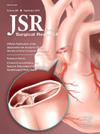重型颅脑损伤患者体外膜氧合的生存预测因素
IF 1.7
3区 医学
Q2 SURGERY
引用次数: 0
摘要
体外膜氧合(Extracorporeal Membrane Oxygenation, ECMO)患者的选择需要优化,尤其是重型颅脑损伤(TBI)患者。我们的目的是确定严重TBI患者的生存预测因素。我们还描述了严重TBI患者使用ECMO的趋势。方法回顾性回顾2010-2020年创伤质量改善计划(TQIP)数据库,选择年龄≥18岁、简略损伤评分Head≥3且接受ECMO的患者。我们排除了入院时没有生命迹象或院前心脏骤停的患者,转出或出院的患者,以及入院后14天使用ECMO的患者。我们的主要结局是使用逐步回归分析的生存到出院的预测因子。我们的次要结局是分析脑外伤患者使用ECMO的趋势。结果289例患者,其中164例(57%)存活至出院。在回归分析中,双侧肺撕裂伤和住院心脏骤停是死亡率的预测因子,而年龄和抗凝剂的使用是保护因子。TBI患者接受ECMO的比例逐渐增加,死亡率无明显变化。在研究期间,与学术场所相比,在社区和非教学场所进行ECMO的病例比例增加。结论secmo在创伤性脑损伤患者中的应用越来越广泛。无肺裂伤和抗凝绝对禁忌症的年轻患者可能从ECMO中获益最多。本文章由计算机程序翻译,如有差异,请以英文原文为准。
Predictors of Survival in Patients With Severe Traumatic Brain Injury Undergoing Extracorporeal Membrane Oxygenation
Introduction
The selection of patients for Extracorporeal Membrane Oxygenation (ECMO) needs to be optimized, especially in patients with severe traumatic brain injury (TBI). We aimed to identify predictors of survival in severe TBI patients. We also characterized trends of ECMO use in patients with severe TBI.
Methods
We retrospectively reviewed the Trauma Quality Improvement Program (TQIP) database for 2010-2020 and selected patients ≥18 years old with an Abbreviated Injury Score Head ≥3 who underwent ECMO. We excluded patients without signs of life on arrival or prehospital cardiac arrest, patients transferred out or discharged against medical advice, and patients with ECMO use >14 d after admission. Our primary outcome was predictors of survival to discharge using a stepwise regression analysis. Our secondary outcome was to analyze the trends in ECMO use among TBI patients.
Results
We included 289 patients, of whom 164 (57%) survived to discharge. In the regression analysis, bilateral pulmonary laceration and in-hospital cardiac arrest were predictors of mortality, while age <50 years and anticoagulant use were protective. The proportion of patients with TBI undergoing ECMO gradually increased, with no significant change in mortality rates. An increasing proportion of ECMO cases were performed at community and nonteaching sites compared to academic sites during the study period.
Conclusions
ECMO is increasingly being utilized in trauma patients with TBI. Young patients without pulmonary laceration and absolute contraindications to anticoagulation may benefit most from ECMO.
求助全文
通过发布文献求助,成功后即可免费获取论文全文。
去求助
来源期刊
CiteScore
3.90
自引率
4.50%
发文量
627
审稿时长
138 days
期刊介绍:
The Journal of Surgical Research: Clinical and Laboratory Investigation publishes original articles concerned with clinical and laboratory investigations relevant to surgical practice and teaching. The journal emphasizes reports of clinical investigations or fundamental research bearing directly on surgical management that will be of general interest to a broad range of surgeons and surgical researchers. The articles presented need not have been the products of surgeons or of surgical laboratories.
The Journal of Surgical Research also features review articles and special articles relating to educational, research, or social issues of interest to the academic surgical community.

 求助内容:
求助内容: 应助结果提醒方式:
应助结果提醒方式:


